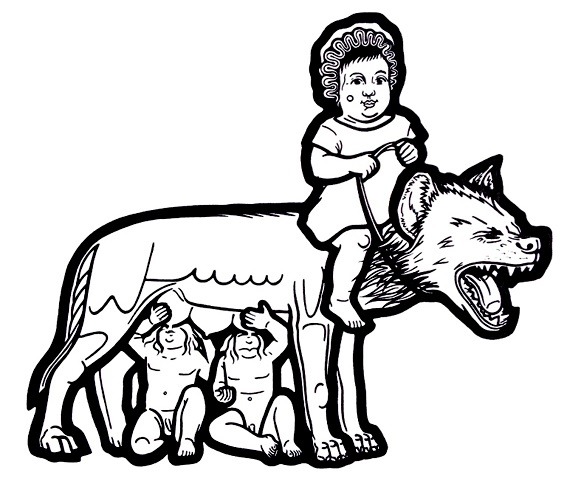Mary Wollstonecraft. Frankenstein’s monster. The Capitoline Wolf. Mary Shelley. Four names, four figures forming a strange kind of family, if we can call it that. Perhaps better to say, ‘a pack’. Each is linked to other in a lineage of imagination, creation, or birth. There is a shared marginality. Each was believed somehow to have transgressed, to have been born unnatural or committed unnatural deeds. And so, across multiple times and places – from ancient Rome to eighteenth-century London – and multiple layers of reality – myth, history, a night-time vision, a nightmare of a novel – each was confined to the edges of civilised society. Like Hobbes’ Leviathan, civilisation would time and again prove itself more monstrous than the monster.
In this series of four ink-on-paper drawings, artist Laura Moreton-Griffiths threads together moments from diverse narratives of violence, loneliness, bravery, and ostracism. In 1792 Mary Wollstonecraft published A Vindication of the Rights of Women, in which she argued that any intellectual inequality between men and women was the result of social, political and economic circumstances (shaped by men) – namely, a lack of education. In arguing against a natural explanation for gendered identity, she was herself branded unnatural. ‘A hyena in a petticoat,’ was Horace Walpole’s double-edged barb.
Laura Moreton-Griffiths threads together moments from diverse narratives of violence, loneliness, bravery, and ostracism.
In 1797, Wollstonecraft gave birth to Mary Shelley (as she came to be known). But the thread of motherhood was quickly severed: the (male) doctor at her bedside believed her breast milk to be toxic and so placed a pair of puppies at her nipples to suckle away the milk. Amid this horror, Moreton-Griffiths alerts us to the inverted parallel with the Capitoline Wolf, which suckled Romulus and Remus, the twins whose fratricide would found an empire. It has been said many times that lupa, the Latin for ‘wolf’, was also slang for a prostitute: maybe the wolf was a woman after all. We will never know. Shortly after her ordeal, Wollstonecraft died, leaving her daughter to grow up motherless.
While the suckling wolf exists in countless reproductions, Wollstonecraft and Shelley are remembered today for their writings – Shelley, especially, for Frankenstein, a story of modernity and monstrosity, science, superstition and unnatural births. Thanks to the pen of Moreton-Griffiths, a new family has formed. The artist draws strong lines around them all.
Mary
Activist, philosopher. Mary Wollstonecraft broke the rules, argued back. Hyena in petticoats. She called for women and girls to be rational, educated – to have equal rights to life, liberty and happiness.
Indian ink on Saunders Waterford paper (2015)
Mary’s Monster
Ultimate sexist. Mary’s monster. Obstacle to equality neither natural nor divine – built of the power of kings, priests, statesman and superstition, death mask of Rousseau and Burke, eyes of a man from Britain’s Got Talent.
Indian ink on Saunders Waterford paper (2015)
Empire Builders
A few days after giving birth Mary lay dying. Believing her breast milk toxic, her doctor took her newborn baby away and made her suckle puppies. Monstrous half-being. She-wolf. Empire builder personified.
Indian ink on Saunders Waterford paper (2015)
Bringing Up Women
Her daughter never knew her mother. Understanding what it is like to live outside society, she wrote Frankenstein, melancholic tale of a man made man that unloved becomes a monster.
Indian ink on Saunders Waterford paper (2015)
Introduction by Tom Jeffreys.
Part of The Learned Pig’s Wolf Crossing editorial season, spring/summer 2017.





